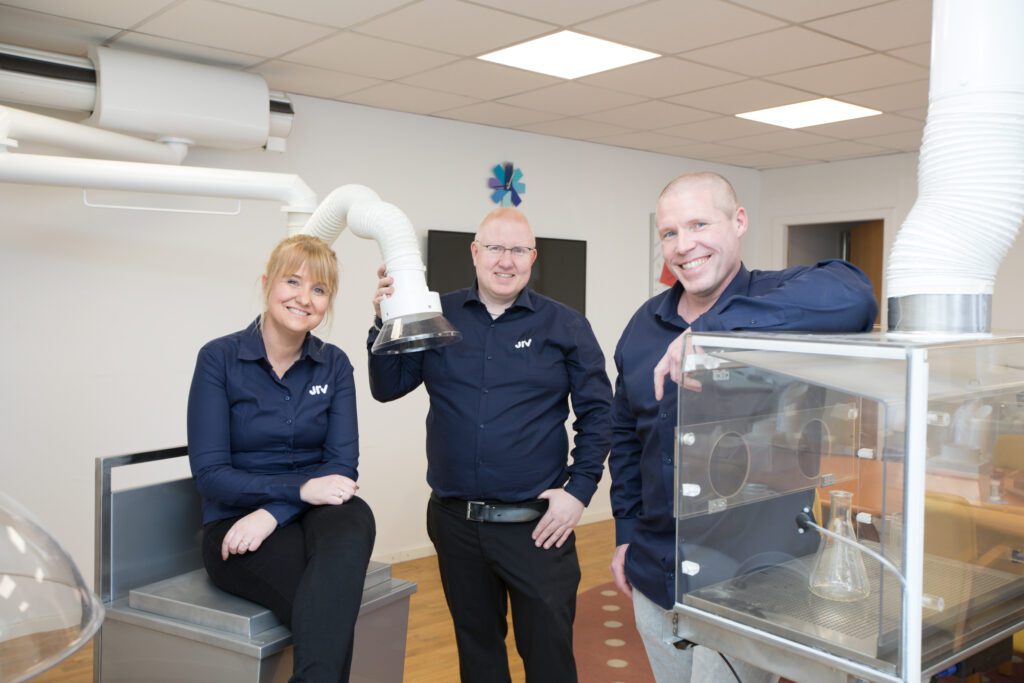Hospitals and Clinics
Personal Safety for You and Your Colleagues
THE OPERATING ROOM
During surgeries, anesthesia, and bone cementing in the operating room, staff may be exposed to harmful substances such as surgical smoke, anesthetic gases, bone cement fumes, particles, and bacteria. For these processes, the use of extraction arms and at-source filters is recommended, as well as Laminar Air Flow (LAF) when a particle-free zone is required.
Flexible and Low-Noise Extraction Arm
Our extraction arm provides a flexible and durable solution that effectively removes surgical smoke, anesthetic gases, and bone cement fumes. Our extraction arms are already in use at several hospitals and specialized clinics across the country.
What makes our extraction arms stand out is their easy maneuverability and unique brake function, which makes it simple to position and hold the arm exactly where it is needed.
What makes our extraction arms stand out is their easy maneuverability and unique brake function, which makes it simple to position and hold the arm exactly where it is needed.
At-Source Filters for Surgeries
With an at-source filter mounted on the extraction arm, particles are captured directly in the filter, preventing them from accumulating in the arm or spreading into the ventilation system. We offer both sterile and non-sterile at-source filters.
Hoods for Extraction Arms
When using an extraction arm for medicine preparation and dispensing, it is important to select the right hood for the process.
Surgical Sink
We have supplied stainless steel surgical sinks to multiple clinics and hospitals for handwashing before and after surgeries, as well as for other minor procedures.
Sterile Hose Covers
By placing a sterile hose cover over the extraction arm, it can be moved into the sterile zone, allowing extraction directly at the operating table.
Diathermy Suction
Our diathermy suction system can be integrated into our extraction arms and activates instantly when the diathermy pen is in use. The system ensures powerful suction, effectively removing surgical smoke, bacteria, and viruses.
With the option to connect multiple electrosurgical pens simultaneously, this solution provides maximum flexibility in the operating room.
With the option to connect multiple electrosurgical pens simultaneously, this solution provides maximum flexibility in the operating room.
Low-Noise LAF for Your Operating Room
With a LAF (Laminar Air Flow) unit, you can create a particle-free zone in the operating room. By filtering the air, particles and microbes from both staff and patients are effectively removed.
Remove Cables and Hoses from the Floor with a Medical Supply Bridge
A medical supply bridge allows you to remove equipment such as hoses and cables from the floor area, reducing the risk of accidents in the operating room. In addition, the bridge can be equipped with gas outlets and electrical sockets.
THE MEDICINE ROOM
For the analysis of cell and tissue samples, as well as the preparation and dispensing of medicines and intravenous drugs, it is recommended to use a fume cabinet or a LAF safety cabinet. With either of these solutions, the work process is encapsulated, and formalin vapors and aerosols are removed—protecting both the user and the surroundings from exposure.
Fume Cabinets for Dosing and Tissue Samples
Our fume cabinets, also known as extraction cabinets or enclosures, are designed for handling samples as well as for the preparation and dispensing of medicines, formalin, and similar processes.
When analyzing cell and tissue samples, or preparing and dispensing medicines inside the fume cabinet, your work process is fully encapsulated. The cabinet effectively removes generated dust, fumes, or aerosols, ensuring that neither you nor your surroundings are exposed.
When analyzing cell and tissue samples, or preparing and dispensing medicines inside the fume cabinet, your work process is fully encapsulated. The cabinet effectively removes generated dust, fumes, or aerosols, ensuring that neither you nor your surroundings are exposed.
LAF Safety Cabinet for Dosing and Tissue Samples with High Purity Requirements
For the analysis of cell and tissue samples, as well as for the preparation and dispensing of medicines in larger quantities or when higher purity standards are required, it is recommended to encapsulate the work process in a LAF safety cabinet.
A LAF safety cabinet provides a ventilated, sterile workspace equipped with a built-in HEPA H14 filter. This ensures that generated dust, fumes, or aerosols do not contaminate the surroundings or affect you while working inside the cabinet.
A LAF safety cabinet provides a ventilated, sterile workspace equipped with a built-in HEPA H14 filter. This ensures that generated dust, fumes, or aerosols do not contaminate the surroundings or affect you while working inside the cabinet.
Health and Safety Requirements
At permanent workplaces, local exhaust ventilation is required whenever work processes generate harmful or disturbing air contaminants such as gases, dust, smoke, microorganisms, aerosols, or unpleasant odors.

Hospitals We Have Worked With
Rigshospitalet, Copenhagen
Sahlgrenska University Hospital, Sweden
Oslo University Hospital
Aarhus University Hospital
Skåne University Hospital, Lund
University Hospital of North Norway Narvik, UNN
Örebro University Hospital
Aleris Hamlet Hospital A/S
Private Hospital Mølholm A/S, Denmark
Hospital of Southern Jutland, Sønderborg
Odense University Hospital (OUH)
Zealand University Hospital, Roskilde
Randers Regional Hospital
Capio A/S
Aalborg University Hospital
University Hospital of Southern Denmark, Esbjerg
Bispebjerg Hospital
Næstved Hospital
Zealand University Hospital, Nykøbing Falster
Clinics We Have Worked With
AK Nygart A/S, Denmark
Lift Clinic A/S
CeriXClinic
We Are Here to Help You
You are always welcome to send us an email or give us a call if you have any questions. We will do our best to respond as quickly as possible.

